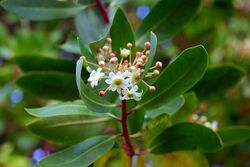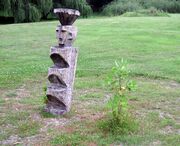Biology:Drimys winteri
| Drimys winteri | |
|---|---|

| |

| |
| Young adult | |
| Scientific classification | |
| Kingdom: | Plantae |
| Clade: | Tracheophytes |
| Clade: | Angiosperms |
| Clade: | Magnoliids |
| Order: | Canellales |
| Family: | Winteraceae |
| Genus: | Drimys |
| Species: | D. winteri
|
| Binomial name | |
| Drimys winteri J.R. Forst. & G. Forst.
| |
Drimys winteri, the winter's bark or canelo, is a slender tree in the family Winteraceae, growing up to 20 m (66 ft) tall. It is native to the Magellanic and Valdivian temperate rain forests of Chile and Argentina, where it is a dominant tree in the coastal evergreen forests. It is found below 1,200 m (3,900 ft) between latitude 32° south and Cape Horn at latitude 56°. In its southernmost natural range it can tolerate temperatures down to −20 °C (−4 °F).[citation needed] The plant is renowned for its phenotypic plasticity being able to grow in different sites from "extreme arid zones to wetlands along Chile".[2][3] The tree does also grow in places with various types and degrees of competition from other plants.[3]
The leaves are lanceolate, glossy green above, whitish below and can measure up to 20 cm (8 in). The flowers are white with a yellow center, and consist of a great number of petals and stamens. The fruit is a bluish berry.
The height–diameter relation of D. winteri varies greatly. There is for example more spread in D. winteri height–diameter relations than for Nothofagus species.[3] Part of the spread can be explained as reflecting higher tree density that correlates with larger heights for a given diameter.[3] Within its range D. winteri is more frost-tolerant than naturally occurring conifers and vessel-bearing angiosperms such as the Nothofagus.[4] This challenged conventional views that plants without vessels such as D. winteri would be biological relicts poorly adapted to cold.[4]
The canelo is the sacred tree of the Mapuche, who associated it with "good, peace and justice".[5]
History
When Sir Francis Drake sailed round the world in 1577-80, of the four ships accompanying the Golden Hind at the outset, the only ship that successfully reached the entrance to the Strait of Magellan was the Elizabeth, captained by John Wynter. Before entering the Strait, in July 1578, Drake sent Wynter ashore where he learned indigenous people ate the astringent bark.[6] The Elizabeth transversed the Strait. A week later the two ships were separated in a storm and Wynter turned back. Wynter returned in 1580[7] with a supply of Drimys bark, and for centuries before vitamin C was isolated, "Winter's Bark" was esteemed as a preventive and remedy for scurvy— correctly so, for an infusion of D. winteri sustained Captain James Cook and his crew in the South Pacific, and the naturalist accompanying his voyage of exploration, Johann Reinhold Forster, was the first to officially describe and name D. winteri.[8]
Cultivation
Drimys winteri is grown in cool moist climates[9] as an ornamental plant for its red-brown bark, bright green fragrant leaves and its clusters of creamy white jasmine-scented flowers.
The species grows well in southern Great Britain, flourishing as far north as Anglesey. Specimens brought from the southern forests of Tierra del Fuego and planted in the Faroe Islands have proven to be especially hardy.[10]
This plant has gained the Royal Horticultural Society's Award of Garden Merit.[11][12]
It has been planted in the North Pacific Coast of the United States.[13]
The species is considered to have a potential for flood mitigation in northern Chile if planted in valleys.[2]
Other uses
Canelo wood is reddish in color and heavy, with a very beautiful grain. It is used for furniture and music instruments. The wood is not durable outdoors because continuous rainfalls damage it. The wood is not good for making bonfires because it gives off a spicy smoke.
The bark is gray, thick and soft and is used as a pepper replacement in Argentina and Chile. The peppery compound in canelo is polygodial.[14]
D. winteri is an insect repellent and fumigant.[15] Zapata & Smagghe 2010 test the essential oils of bark and leaves and find that both are repellent and usable as a fumigant against Tribolium castaneum.[15]
Notes
- ↑ Botanic Gardens Conservation International (BGCI).; IUCN SSC Global Tree Specialist Group (2018). "Drimys winteri". IUCN Red List of Threatened Species 2018: e.T61968097A135698496. doi:10.2305/IUCN.UK.2018-2.RLTS.T61968097A135698496.en. https://www.iucnredlist.org/species/61968097/135698496. Retrieved 19 November 2021.
- ↑ 2.0 2.1 Bustos-Salazar, Angela; Smith-Ramírez, Cecilia; Zúñiga-Feest, Alejandra; Alves, Fernanda; Ivanovich, Rodrigo (2017). "Which seed origin provides better tolerance to flooding and drought when restoring to face climate change?". Austral Ecology 42 (8): 934–946. doi:10.1111/aec.12521. https://www.researchgate.net/publication/320384888.
- ↑ 3.0 3.1 3.2 3.3 Salas-Eljatib, Christian; Cordvalán, Patricio; Pino, Nicolás; Donoso, Pablo J.; Soto, Daniel P. (2019). "Modelos de efectos mixtos de altura-diámetro para Drimys winteri en el sur (41-43° S) de Chile" (in Spanish). Bosque (Austral University of Chile) 40 (1): 71–80. doi:10.4067/S0717-92002019000100071. https://scielo.conicyt.cl/scielo.php?pid=S0717-92002019000100071&script=sci_arttext.
- ↑ 4.0 4.1 Feild, Taylor S.; Brodribb, Tim; Holbrook, N. Michele (2002). "Hardly a relict: Freezing and the evolution of vesselless wood in Winteraceae". Evolution 56 (3): 464–478. doi:10.1111/j.0014-3820.2002.tb01359.x. PMID 11989678. https://onlinelibrary.wiley.com/doi/pdf/10.1111/j.0014-3820.2002.tb01359.x.
- ↑ Montecino Aguirre, Sonia (2015). "Canelo" (in es). Mitos de Chile: Enciclopedia de seres, apariciones y encantos. Catalonia. p. 126–127. ISBN 978-956-324-375-8.
- ↑ Lynch, Robert G.; Spivak, Samuel (2017). Two Voyages to the Pacific Coast of North America: Francis Drake and Brune de Hezeta, Their Voyages Compared with Information about Scurvy. San Francisco: Drake Navigators Guild. p. 37.
- ↑ Coote, Stephen (2005). Drake: The Life and Legend of an Elizabethan Hero. New York: Thomas Dunne Books. ISBN 9780743468701.
- ↑ Alice M. Coats, Garden Shrubs and Their Histories (1964) 1992, s.v. "Drimys".
- ↑ John L. Creech, providing American garden notes for Coats 1992, remarks of D. winteri and Tasmanian D. aromatica, both grown in British gardens, "These two species have not had much success here"; Drimys winteri is grown in the San Francisco Botanical Garden : (Capt. Winter is identified as "William Winter").
- ↑ Højgaard, A., J. Jóhansen, and S. Ødum (eds) 1989. A century of tree planting in the Faroe Islands. Føroya Frodskaparfelag, Torshavn.
- ↑ "Drimys winteri". Royal Horticultural Society. https://www.rhs.org.uk/Plants/31925/Drimys-winteri/Details.
- ↑ "AGM Plants - Ornamental". Royal Horticultural Society. July 2017. p. 33. https://www.rhs.org.uk/plants/pdfs/agm-lists/agm-ornamentals.pdf.
- ↑ "Drimys winteri in Washington Park Arboretum". Seattle Government. http://www.seattle.gov/parks/proparks/projects/ArboretumReport.pdf.
- ↑ Muñoz-Concha, D., Vogel, H., Yunesc, R., Razmilic, I., Brescianic, L., and Malheiros, A., Presence of polygodial and drimenol in Drimys populations from Chile, Biochemical Systematics and Ecology, Volume 35, Issue 7, July 2007, Pages 434-438
- ↑ 15.0 15.1
- Zapata, Nelson; Smagghe, Guy (2010). "Repellency and toxicity of essential oils from the leaves and bark of Laurelia sempervirens and Drimys winteri against Tribolium castaneum". Industrial Crops and Products (Elsevier) 32 (3): 405–410. doi:10.1016/j.indcrop.2010.06.005. ISSN 0926-6690.
- Spochacz, Marta; Chowański, Szymon; Walkowiak-Nowicka, Karolina; Szymczak, Monika; Adamski, Zbigniew (2018-07-26). "Plant-Derived Substances Used Against Beetles-Pests of Stored Crops and Food-and Their Mode of Action: A Review". Comprehensive Reviews in Food Science and Food Safety (Institute of Food Technologists (Wiley)) 17 (5): 1339–1366. doi:10.1111/1541-4337.12377. ISSN 1541-4337. PMID 33350162.
- Mossa, Abdel-Tawab H. (2016-08-15). "Green Pesticides: Essential Oils as Biopesticides in Insect-pest Management". Journal of Environmental Science and Technology (ANSInet) 9 (5): 354–378. doi:10.3923/jest.2016.354.378. ISSN 1994-7887.
References
- Hoffmann, Adriana (1997), Flora silvestre de Chile zona araucana: Una guía ilustrada para la identificación de las especies de plantas leñosas del sur de Chile (entre el río Maule y el seno de Reloncaví)., Santiago: El Mercurio. ISBN:956-7743-01-0.
External links
- History, botanical origin, description, etc. Hanburgy, Daniel and Friedrich August Flückiger (1879). Pharmacographia; a History of the Principal Drugs of Vegetable Origin... London: Macmillan and Co. pp 17–20.
- "Drimys winteri in Crarae Gardens, Scotland". Dendrological Plant Image Gallery. http://www.dendroimage.de/2188.htm.
Wikidata ☰ Q775529 entry



